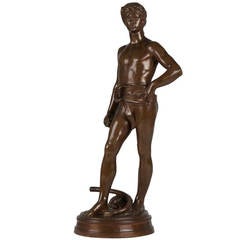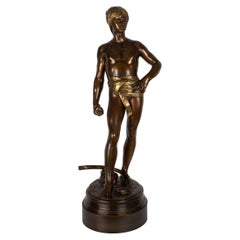Mercie David Avant Le Combat Bronze
Recent Sales
Antique 19th Century French Romantic Sculptures
Bronze
Antique 19th Century French Figurative Sculptures
Bronze
F. Barbedienne Foundry for sale on 1stDibs
Founded by one-time Parisian wallpaper dealer Ferdinand Barbedienne and engineer Achille Collas, one of the most revered foundries in 19th-century France began with the invention of a revolutionary 1830s-era device that could produce proportional reproductions — large or small — of sculptures. Collas’s machine, which yielded miniature likenesses of antiquities for the interiors of homes the world over, was pivotal to the success of the F. Barbedienne Foundry. The successful firm earned prestigious awards and critical acclaim and created exquisite bronze candleholders, clocks and lamps for a range of wealthy and prominent clients.
The duo first launched their company under the name Société Collas et Barbedienne, and early on, they optimized chemical processes for pigmenting and patinating their bronze statuettes. After Collas died in 1859, Barbedienne forged on alone, and the company’s name changed to simply F. Barbedienne.
Barbedienne employed more than 300 workers at that point, and the Maison created a range of furnishings and decorative objects that featured the integration of marble and ormolu accents. However, with the onset of the Franco-Prussian War of 1870, the foundry was forced to retrofit its molds, and the production of cannons replaced sculptures, furniture and vases.
When Ferdinand Barbedienne passed away in 1891, his nephew and heir, Gustave Leblanc, took over as president, changing the name to Leblanc-Barbedienne. Leblanc expanded production into Germany, the United Kingdom and the United States, carrying on the company's legacy with monumental sculptures, and models and securing production rights for famous statues. Paul-Alexandre Dumas, an Art Nouveau maker and student of Louis Majorelle, succeeded Leblanc until the company's closing in 1952.
Barbedienne pieces had been exhibited regularly in the 19th century and were especially prevalent at Europe’s international expositions and world’s fairs, where they received numerous awards. Today, the Musée d’Orsay in Paris holds dozens of Barbedienne works in its collection, including intricate mirrors, vases and cups created by Louis-Constant Sévin at the foundry. For more than two decades, Sévin created lamps, boxes and more at Maison Barbedienne. Working alongside award-winning chaser Désiré Attarge, Sévin designed Napoleon III-era works that greatly appealed to European nobility.
Other notable artists who collaborated with Barbedienne included Eugene Aizelin, Emmanuel Fremiet, Antonin Mercié, Emile Guillemin, Edouard Lievre, Ferdinand Levillain and Auguste Rodin.
On 1stDibs, find a collection of Barbedienne decorative objects, lighting and collectibles.
Finding the Right sculptures for You
Styling your home with vintage, new and antique sculptures means adding a touch that can meaningfully transform the space. By introducing a sculptural work as a decorative finish to any interior, you’re making a statement, whether you tend toward the dramatic or prefer to keep things casual with modest, understated art.
A single, one-of-a-kind three-dimensional figurative sculpture mounted on your dining room wall is a guaranteed conversation piece, while a trio of abstract works arranged on your living room bookshelves can add spontaneity to the collection of first-edition novels or artist monographs you’re displaying as well as draw attention to them. Figurative sculptures are representational works that portray a specific person, animal or object. And while decorating with busts, which are sculpted or cast figurative works, hasn’t exactly topped the list of design trends every year, busts are back. According to designer Timothy Corrigan, “They give humanity in a way that a more abstract sculpture can’t give.” Abstract sculptures, on the other hand, are not meant to show something specific. Instead, they invoke a mood or scene without directly stating what they are portraying.
Busts made of stone or metal may not seem like a good fit for your existing decor. Fortunately, there are many ways for a seemingly incongruous piece to fit in with the rest of your room’s theme. You can embrace a dramatic piece by making it the focal point of the room, or you can choose to incorporate several elements made out of the same material to create harmony in your space. If an antique or more dramatic piece doesn’t feel like you, why not opt for works comprising plastic, fiberglass or other more modern materials?
When incorporating sculpture into the design of your home — be it the playful work of auction hero and multimedia visionary KAWS, contemporary fiber art from Connecticut dealer browngrotta arts or still-life sculpture on a budget — consider proper lighting, which can bring out the distinctive aspects of your piece that deserve attention. And make sure you know how the size and form of the sculpture will affect your space in whole. If you choose a sculpture with dramatic design elements, such as sharp angles or bright colors, for example, try to better integrate this new addition by echoing those elements in the rest of your room’s design.
Get started on decorating with sculpture now — find figurative sculptures, animal sculptures and more on 1stDibs today.

